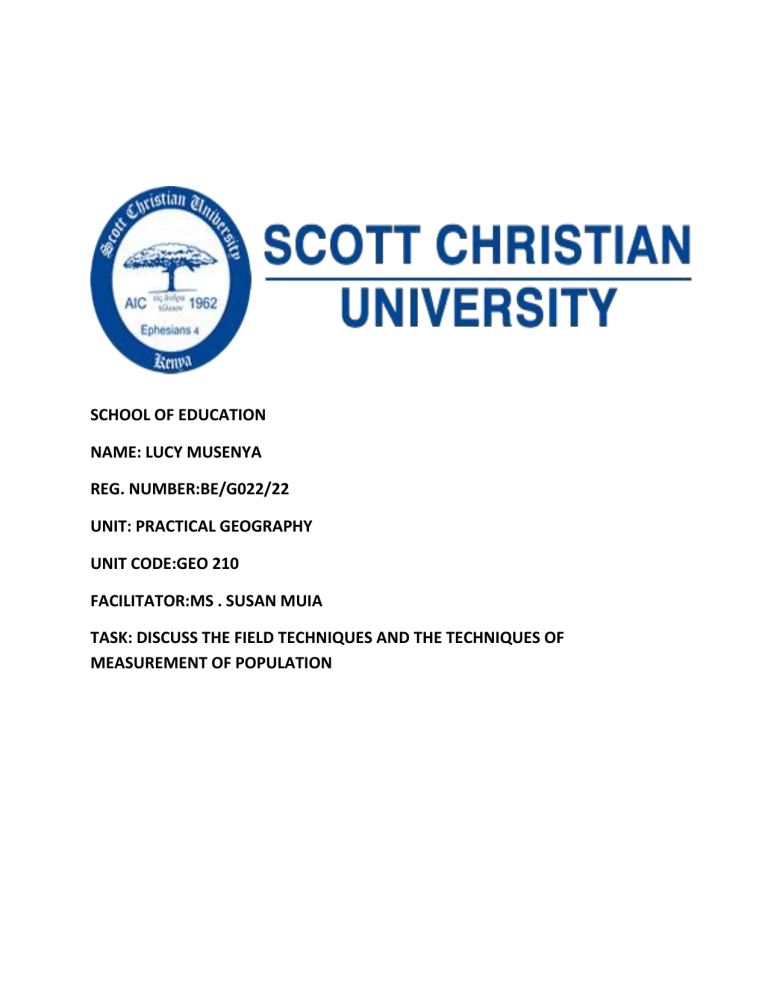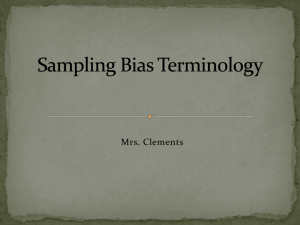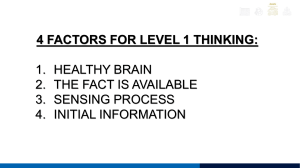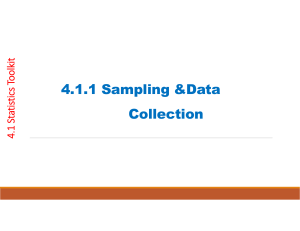Field Techniques & Population Measurement: Geography Assignment
advertisement

SCHOOL OF EDUCATION NAME: LUCY MUSENYA REG. NUMBER:BE/G022/22 UNIT: PRACTICAL GEOGRAPHY UNIT CODE:GEO 210 FACILITATOR:MS . SUSAN MUIA TASK: DISCUSS THE FIELD TECHNIQUES AND THE TECHNIQUES OF MEASUREMENT OF POPULATION Field techniques and measurement methods for population play a crucial role in understanding the demographics, dynamics, and characteristics of a population. These techniques are diverse, ranging from traditional approaches like censuses to modern technologies such as remote sensing. Here's a broader discussion on these methods: 1.SAMPLE SURVEYS In a sample survey, only part of the total population is approached for information on the topic under study. These data are then 'expanded' or 'weighted' to make inferences about the whole population. We define the sample as the set of observations taken from the population for the purpose of obtaining information about the population. Advantages of Sample Surveys compared with Censuses: Reduces cost - both in monetary terms and staffing requirements. Reduces time needed to collect and process the data and produce results as it requires a smaller scale of operation. (Because of the above reasons) enables more detailed questions to be asked. Enables characteristics to be tested which could not otherwise be assessed. An example is life span of light bulbs, strength of spring, etc. To test all light bulbs of a particular brand is not possible as the test needs to destroy the product so only a sample of bulbs can be tested. Importantly, surveys lead to less respondent burden, as fewer people are needed to provide the required data. Results can be made available quickly Disadvantages of Sample Surveys compared with Censuses: Data on sub-populations (such as a particular ethnic group) may be too unreliable to be useful. Data for small geographical areas also may be too unreliable to be useful. (Because of the above reasons) detailed cross-tabulations may not be practical. Estimates are subject to sampling error which arises as the estimates are calculated from a part (sample) of the population. May have difficulty communicating the precision (accuracy) of the estimates to users. Sample Survey Design Considerations When running a sample survey, there are several design considerations that need to be taken into account that are specific to sample surveys. These additional factors include: sample size, sample design, the mode of estimation based on survey results and, where applicable, stratification, allocation of the sample across the strata and the selection of the sample within the strata. These factors, however, depend on many other factors such as the objectives of the survey, nature of target population, data items to be collected, level of accuracy required etc. 2.CENSUSES A census is a collection of information from all units in the population or a 'complete enumeration' of the population. We use a census when we want accurate information for many subdivisions of the population. Such a survey usually requires a very large sample size and often a census offers the best solution. Advantages of Censuses compared with Sample Surveys: The advantages of a census are that: Data for small areas may be available, assumimg satisfactory response rates are achieved. Data for sub-populations may be available, assumimg satisfactory response rates are achieved. (Because of the above reasons) detailed cross-tabulations may be possible. The estimates are not subject to sampling error. An examination of these shows that these closely reflect the disadvantages of a sample survey. Similarly, the disadvantages of censuses relate to the advantages of sample surveys. 3.MARK AND RECAPTURE Mark and recapture is a method commonly used in ecology to estimate an animal population's size where it is impractical to count every individual.[1] A portion of the population is captured, marked, and released. Later, another portion will be captured and the number of marked individuals within the sample is counted. Since the number of marked individuals within the second sample should be proportional to the number of marked individuals in the whole population, an estimate of the total population size can be obtained by dividing the number of marked individuals by the proportion of marked individuals in the second sample. Other names for this method, or closely related methods, include capture-recapture, capture-mark-recapture, mark-recapture, sight-resight, mark-releaserecapture, multiple systems estimation, band recovery, the Petersen method,and the Lincoln method. Another major application for these methods is in epidemiology,where they are used to estimate the completeness of ascertainment of disease registers. Typical applications include estimating the number of people needing particular services (i.e. services for children with learning disabilities, services for medically frail elderly living in the community), or with particular conditions 4.CAMERA TRAPS The use of camera traps to estimate population size when animals are not individually recognizable is gaining traction in the ecological literature, because of its applicability in population conservation and management. We estimated population size of synthetic animals with four camera trap sampling-based statistical models that do not rely on individual recognition. Using a realistic model of animal movement to generate synthetic data, we compared the random encounter model, the random encounter and staying time model, the association model and the time-to-event-model and we investigated the impact of violation of assumptions on the population size estimates. While under ideal conditions these models provide reliable population estimates, when synthetic animal movements were characterised by differences in speed (due to diverse behaviours such as locomotion, grazing and resting) none of the model provided both unbiased and precise density estimates. The random encounter model and the time-to-event-model provided precise results but tended to overestimate population size, while the random encounter and staying time model was less precise and tended to underestimate population size. Lastly, the association model was unable to provide precise results. We found that each tested model was very sensitive to the method used to estimate the range of the field-of-view of camera traps. Density estimates from both random encounter model and time-toevent-model were also very sensitive to biases in the estimate of animals’ speed. We provide guidelines on how to use these statistical models to get population size estimates that could be useful to wildlife managers and practitioners. 5.SAMPLING Total population sampling is a type of purposive sampling technique where you choose to examine the entire population (i.e., the total population) that have a particular set of characteristics. In sampling, units are the things that make up the population. Units can be people, cases (e.g., organisations, institutions, countries, etc.), pieces of data, and so forth. When using total population sampling, it is most likely that these units will be people. In any piece of research, units have certain characteristics that help to define them. For example, if the units of interest are people, they can be defined by certain attributes/traits (e.g., age, gender, occupation, health-status, etc.), experiences (e.g., an assault, the break-up of a marriage, a trip to a concert, etc.), attitudes (e.g., supporters of a certain political party, pro-choice in the abortion debate, etc.), and so forth. A sample may be defined by a small/ large number of characteristics, a narrow/wide range of characteristics, and so forth. In the case of total population sampling, the units of interest tend to have some characteristics that are not very common. It is important to note that only some characteristics are not very common, but since it is these characteristics that we are interested in, they influence our choice of total population sampling. 6.GIS (Geographic Information System): GIS integrates spatial data to analyze and visualize population distribution, helping identify patterns and trends.Facilitates the understanding of how populations are distributed geographically. Requires skilled personnel for analysis and interpretation. 7.Demographic Analysis Focuses on vital statistics such as births, deaths, and migrations to estimate population changes over time.Offers insights into population dynamics and trends. Relies on the availability and accuracy of historical demographic data 8.Biometric Techniques Involves using unique physical or behavioral characteristics for population measurement.Common in individual identification and authentication. Raises privacy concerns, may not be suitable for large-scale population studies but is effective for certain applications. Conclusion Each technique has its advantages and limitations, and the choice depends on factors like the population size, available resources, desired level of detail, and the specific objectives of the study. Often, a combination of these methods provides a more comprehensive understanding of the population under investigation. Advances in technology continue to shape and enhance these techniques, making population measurement an evolving and dynamic field of study. References Batty, M. and P. Longley, 1994, Fractal Cities: A Geometry of Form and Function,London, UK/San Diego, CA: Academic Press, 394 p. Bracken, I., 1991, “A Surface Model Approach to Small Area Population Estima-tion,” Town Planning Review, 62(2):225-237. Bracken, I. and D. Martin, 1989, “The Generation of Spatial Population Distributionsfrom Census Centroid Data Source,” Environment and Planning A, 21(4):537-543.Chen, K., 2002, “An Approach to Linking Remotely Sensed Data and Areal Census Data,” International Journal of Remote Sensing, 23(1):37-48. Clark, C., 1951, “Urban Population Densities,” Journal of the Royal StatisticalSociety, 114:490-496. Clayton, C. and J. Estes, 1980, “Image Analysis as a Check on Census Enumeration Accuracy,” Photogrammetric Engineering and Remote Sensing, 46:757-764. Collins, W. G. and A. H. A. El-Beik, 1971, “Population Census with the Aid of Aerial Photographs: An Experiment in the City of Leeds,” Photogrammetric Record,7:16-26. Dempster, A. P., Laird, N. M., and D. B. Rubin, 1977, “Maximum Likelihood fromIncomplete Data via the EM Algorithm,” Journal of Royal Statistics SocietySeries B–Methodological, 39(1):1-38. Dobson, J. E., Bright, E. A., Coleman, P. R., Durfee, R. C., and B.A. Worley, 2000,“LandScan: A Global Population Database for Estimating Populations at Risk,”Photogrammetric Engineering and Remote Sensing, 66(7):849-857.Donnay, J. P. and D. Unwin, 2001, “Modeling Geographical Distributions in UrbanAreas,” in Remote Sensing and Urban Analysis, Donnay, J. P., Barnsley, M. J.,and P. A. Longley (Eds.), New York, NY: Taylor and Francis, 205-224. Dueker, K. and F. Horton, 1971, “Toward Geographic Urban Change Detection Sys-tems with Remote Sensing Inputs,” Technical Papers, 37th Annual Meeting, American Society of Photogrammetry, 204-218.



